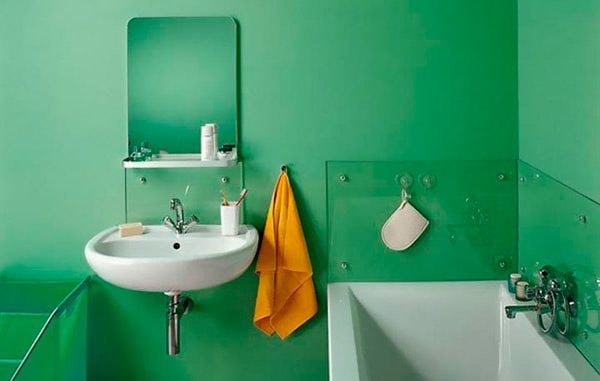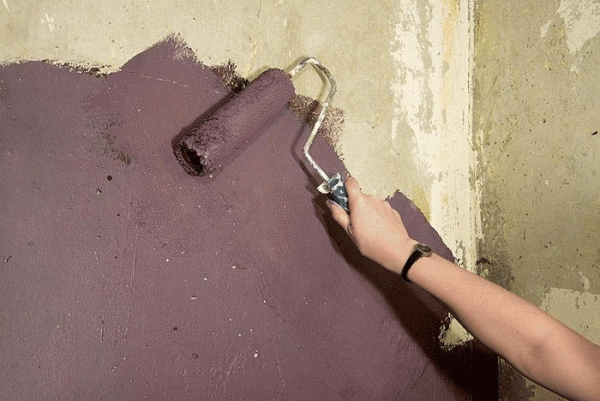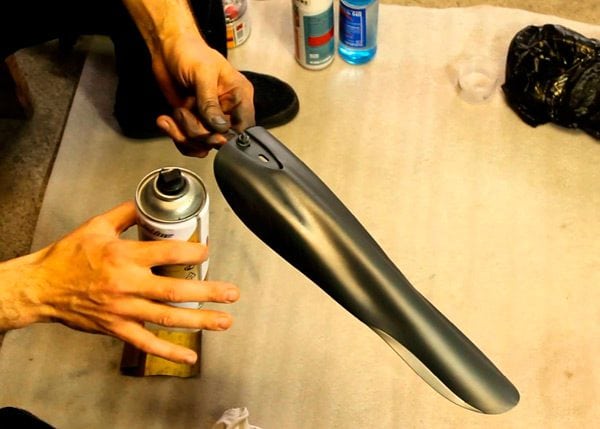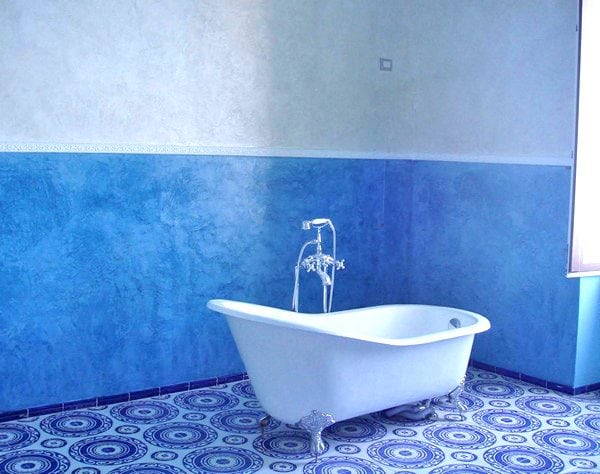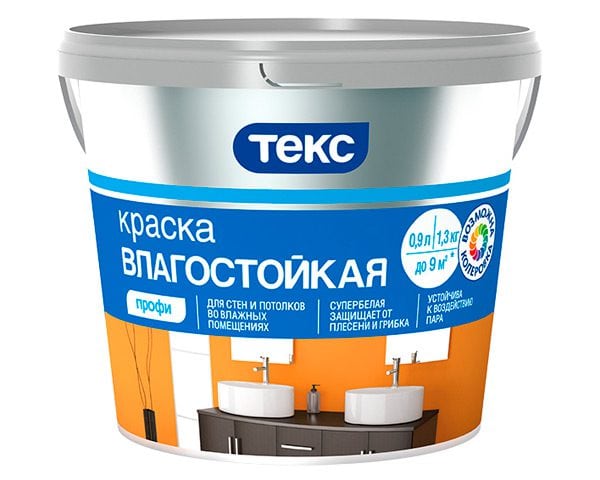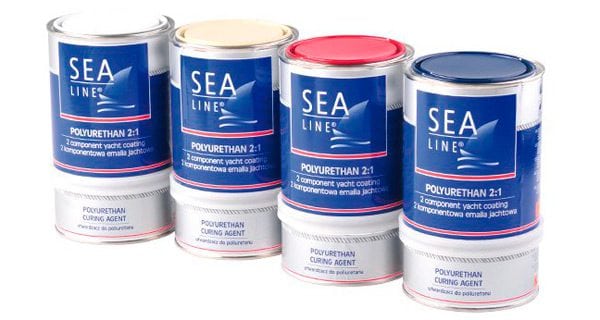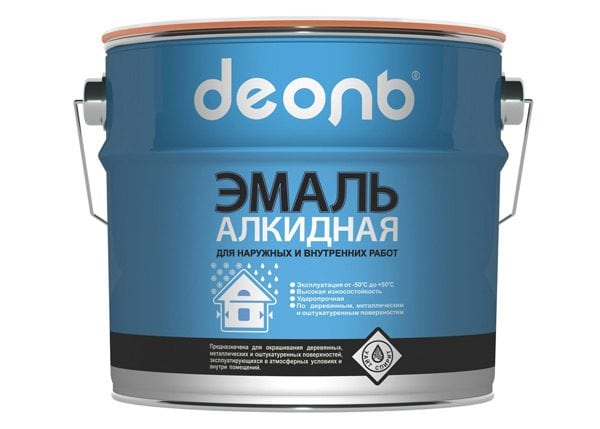Surface finishing by painting is the cheapest and, at the same time, quite effective way to improve the walls in various rooms of the house. A correctly selected waterproof paint and adherence to the technology of its application will have the effect no worse than the use of more expensive schemes. But, for this you need to choose the right type of paint for the walls of the bathroom and living rooms.
- What properties are in demand first
- Is it advisable to paint everything
- Compositions based on water emulsions
- Acrylic based products
- Polyurethane Compounds
- Alkyd Compounds
- Latex products
- What to choose
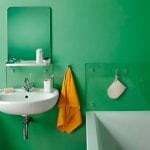
What properties are in demand first
Given the significant labor costs for painting walls (if it is not possible to purchase or rent a spray gun for a while), the main consumer advantage of the paint composition is its hiding power. This is the consumption of material per unit area of walls and / or ceilings in the bathroom and other rooms. However, there are other requirements.
- Environmental Safety. The substance should not contain toxic components. For this reason, oil formulations so popular in the Soviet past, despite their cheapness, are gradually disappearing into oblivion.
- Convenience of technology of drawing on the painted surface. That is why coloring materials on a nitro base are less and less used - if you can still put up with their pungent smell somehow using intensive ventilation of the rooms, then instant drying of such paintwork on the walls of rooms or on glass requires a truly jewelry painting skill. Correct the wrong smear will not work.
- Durability. The coating on the walls should be resistant to fading under the influence of sunlight, and also, should be well kept on a prepared basis (after all, a primer is an essential component of all preparatory work).
- Hygiene The painted surface should completely disconnect the finishing surface from the base (concrete, wood, plaster), otherwise, dust and dirt will begin to accumulate very quickly in the pores, and fungi will also build up in the bathroom, causing mold to form on the walls.
- Aesthetic effect. This primarily concerns living rooms, which are painted relatively rarely. But for technical rooms - kitchen, bathroom, bathroom - the visual impression must necessarily be positive.
Despite the above factors, the main thing for household paint is its moisture resistance. The waterproof composition not only provides easy and pleasant care for the wall or ceiling, but also protects against possible troubles associated, for example, with the sudden flooding of the bathroom by neighbors from above or the breakthrough of pipes of the water heating system.
to contents ↑Unfortunately, universal moisture-resistant paint is an ideal concept. For each type of surface - plywood, glass, metal, concrete, plastic, wood – you can recommend a certain composition of the paintwork, the choice of which is determined by the specific operating conditions of the room.
Is it advisable to paint everything
Of course not. For example, glass is not painted with all compounds.It is more profitable and aesthetic to provide inserts from frosted, colored and other types of opaque glasses (including acrylic). Such glasses look very modern. Moreover, glass inserts can be combined, modified, replaced.
Concrete painting is also rarely done, since concrete can be easily plastered with decorative compounds. As an initial surface, concrete remains mainly in cellars and cellars. In addition, due to the porosity of concrete, paint consumption increases.
There is practically no point in painting plastic and tile. The painted plastic looks much worse, since only by painting with thick paints it is possible to avoid stains. When staining plastic, it is necessary to increase the layer of the coloring composition, and its resistance to plastic will in many cases be minimal due to low adhesion. If the need for painting is great, then the plastic before painting should be treated with an emery cloth.
Plywood (as part of the arrangement of covered balconies and loggias) can also be painted. Processing of plywood is the same as wood. Since plywood more often serves as a substrate for floors made of wood, laminate, etc., it is enough to paint it in one layer.
Wood (parquet in particular) is best not painted at all, but varnished. A well-dried wood is not prone to decay, so it is easier to extend the life of a wood coating with less drastic methods. In addition, it is quite difficult to remove old paint from wood.
to contents ↑Compositions based on water emulsions
Aqueous emulsion paint has certain water-repellent properties, as a result of which it is used in the decoration of walls and ceilings in toilets and kitchens. The water resistance of water-painted wood and plywood is increasing as a result. However, the strength is quite average, why such compositions are not used in rooms with particularly high humidity, for example, in bathrooms and showers.
Low moisture resistance of water-based paints is associated with the following. The matte surface that these compositions form is quite porous. Therefore, over time, water vapor penetrates into the pores. If for living rooms, where the relative humidity rarely exceeds 65-70%, this circumstance is insignificant, then for bathrooms it is almost the main con.
If it is worth using water-based paint, then for decorating exclusively children's rooms - thanks to such advantages:
- brightness (especially if you add a color-forming component there);
- pleasant dullness for the child’s eye (the presence of bright glare has a bad effect on the children's organs of vision);
- lack of smell.
Yes, and not very high durability of water-based emulsion paint in this case will be at hand for parents - the coating that has bothered the children can be easily removed and replaced with the same, but different color. By the way, it is simply impossible to apply another according to the emulsion composition. The old coating must be removed to the base, and then apply a new one. Water-based compositions are not suitable for painting metal, plastic, concrete and glass. But they do not have an unpleasant odor.
to contents ↑Acrylic based products
Acrylic coloring compounds are considered the most universal. They differ:
- bright, smooth surface;
- almost complete absence of smell and toxic components;
- ease of use.
Acrylic paints firmly hold a leading position in the richness of color shades. Choose acrylic color paints for the kitchen, toilet, hallway is often difficult due to the huge selection. The presented list of rooms has no bathrooms, and this is no coincidence. Acrylic is highly resistant to periodically changing relative humidity, but immediately loses its protective properties in cases where excess humidity is constant. This is explained by the following properties of acrylic paints:
- good adhesion only on smooth surfaces (in particular, on plastic, plywood);
- low abrasion resistance of acrylic against constant mechanical stress (for example, cleaning powders or pastes);
- susceptibility to the formation of fungi in hard-to-reach and poorly ventilated places.
to contents ↑Therefore, if the bathroom lacks reliable supply and exhaust ventilation, painting with acrylic compositions will not lead to a significant increase in the moisture resistance of the finish coating.
Polyurethane Compounds
Synthetic paints and varnishes based on high polymer compounds are often used for domestic purposes. They include polyurethane and rubber paints, in which polyurethane is also present. These compounds are not environmentally friendly when applied to the surface, but they have a very high water-repellent effect. This happens because in the process of applying the surface film is additionally polymerized under the influence of oxygen. During this polymerization, the molecules form a long chain through which it is practically impossible to break through moisture (in particular, in the bathroom).
It is also important that the chains of secondary polymerization macromolecules extend in a parallel direction, therefore the surface has some air exchange, “breathes” well and, therefore, does not allow the development of fungal processes. Bathrooms painted with such compounds may not have a powerful ventilation system and at the same time effectively resist the ubiquitous mold.
A clear minus of paints based on polyurethane compositions is their toxicity. Therefore, after staining, the finished surface of the bath should stand for several days until the binding of the macromolecules is over.
At the same time, one should not forget about the universality of such paints and varnishes - they are suitable for processing not only plaster, but also concrete, plastic, metal, glass, plywood and even wood.
to contents ↑Alkyd Compounds
Alkid paints are not inferior to polyurethane in their water repellent properties. However, they contain rather toxic components based on heavy metal alkides. Therefore, the use of such paints should be limited to painting technical rooms with high humidity, such as basements. There, alkyd paints will fully reveal their operational advantages:
- high surface strength;
- the ability to instantly form a thick layer;
- reliable grip on any surface.
When working with such paints and varnishes, considerable caution must be exercised: do not bend over the container with the dye, protect the respiratory system with a gauze bandage or respirator, and work in a well and constantly ventilated area.
to contents ↑Latex products
Of all the paints used in everyday life, the moisture resistance palm belongs to latex. When applied to a surface, latex completely separates the substrate from the environment. At the same time possessing also high surface strength, it will be guaranteed to withstand moisture, for example, in the bathroom. With one exception, a base that does not have the ability to ventilate normally will collapse very quickly. Therefore, latex paints are ideal for moisture resistant processing of metals, reinforced concrete, plastic.
to contents ↑What to choose
With moisture-resistant staining of bathrooms, the walls of which are finished with plaster coatings, plastic, concrete, plywood, acrylic paints will have obvious advantages. For finishing plaster or drywall, but with low requirements for durability, it is permissible to use a water-based paint. When finishing external surfaces, metal (for example, roofing), the use of polyurethane or rubber paints is ideal. Latex is suitable for painting metals, glass and reinforced concrete, while alkyd enamels can very effectively process the walls of basements.

